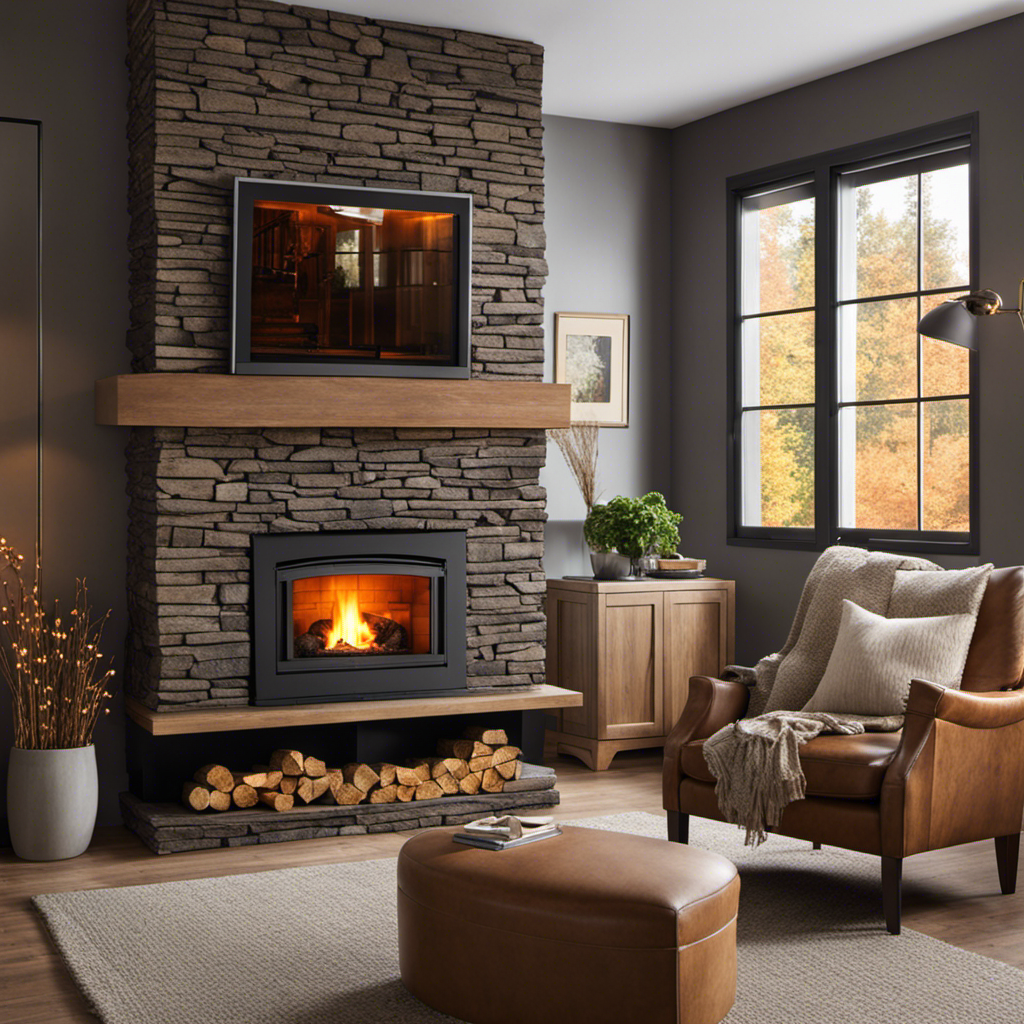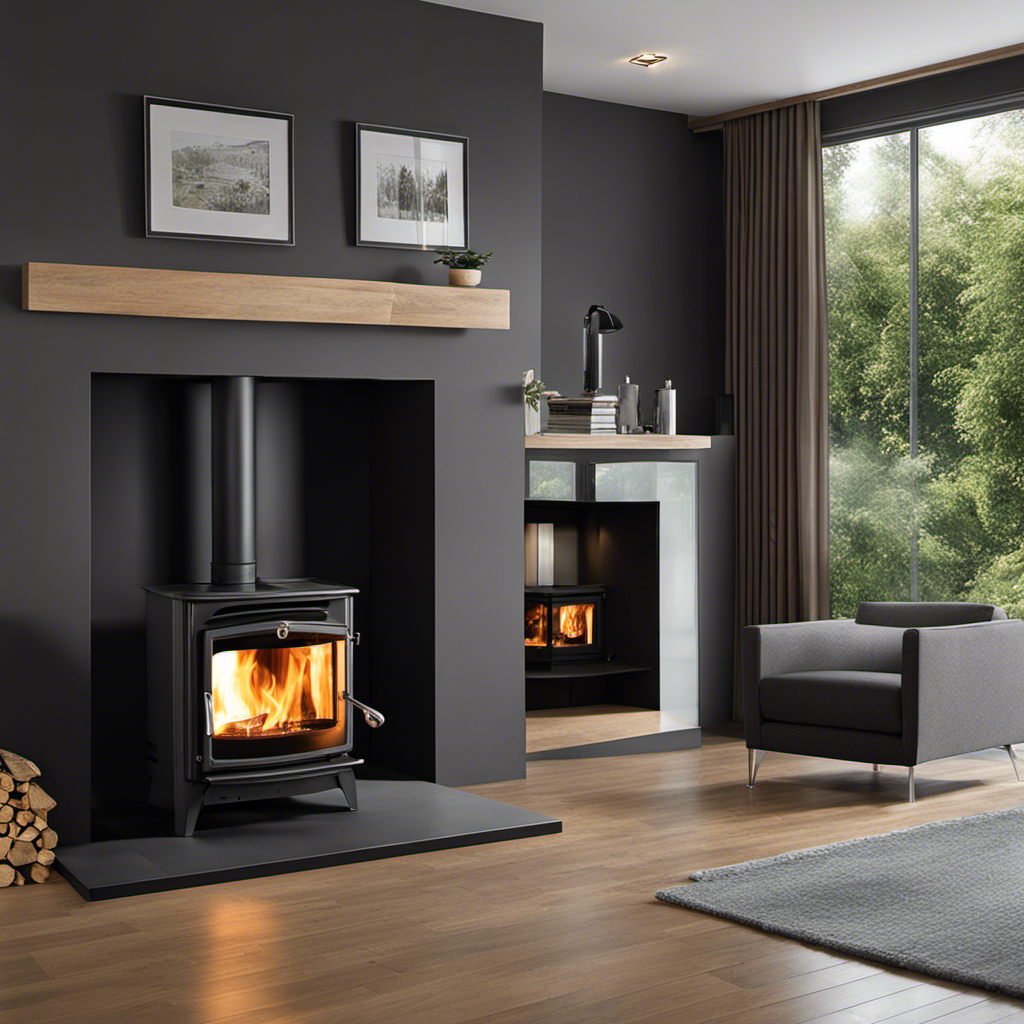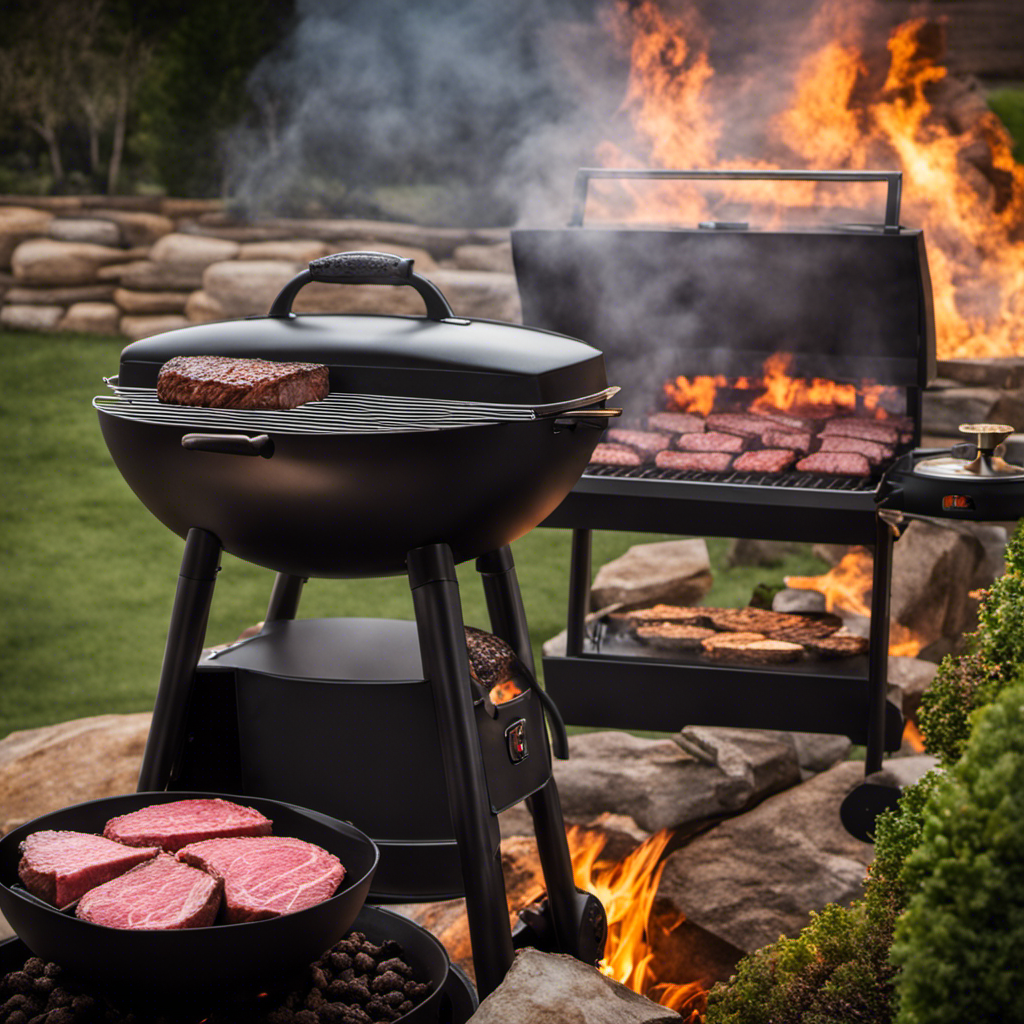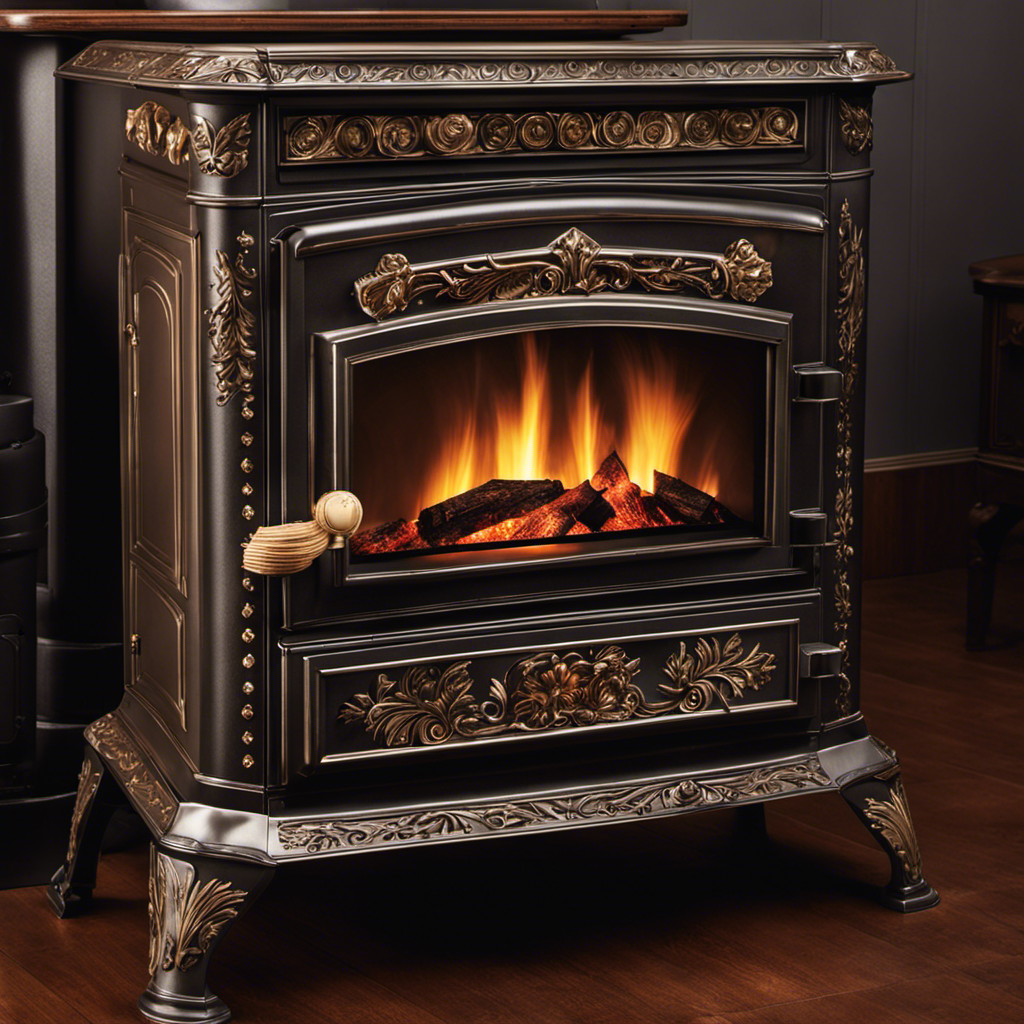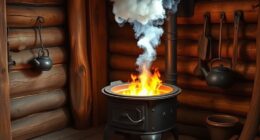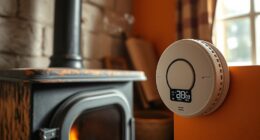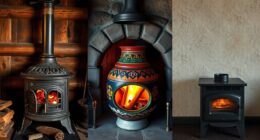I’ve been using a wood pellet fireplace insert for a number of years now, and truly, it has significantly changed the vibe of my home.
Did you know that using a wood pellet fireplace insert can save you up to 50% on heating costs? It’s true!
In this article, I’ll share my expert tips on choosing the right wood pellets, preparing the insert, lighting the pellets, adjusting the heat and airflow, and proper cleaning and maintenance.
Plus, I’ll give you some important safety tips to keep in mind.
Let’s get started!
Key Takeaways
- Choose high-quality wood pellets with low moisture content for optimal heat output and reduced emissions.
- Properly store wood pellets in a dry and ventilated area using airtight containers to maintain their quality.
- Ensure proper ventilation and airflow in the wood pellet fireplace to optimize efficiency and safety.
- Regularly clean and maintain the fireplace, including cleaning the ash, inspecting vents, and lubricating moving parts, to enhance performance and longevity.
Choosing the Right Wood Pellets
When choosing the right wood pellets, it’s important to consider the quality and moisture content. Wood pellet quality is crucial for optimal performance and efficiency in your fireplace insert. Look for pellets made from high-quality wood that has been properly dried and processed. These pellets should have a low moisture content, typically below 10%, to ensure clean and efficient combustion.
Choosing low-quality pellets with high moisture content can result in poor heat output, increased emissions, and potential damage to your fireplace insert. Additionally, consider the environmental impact of the wood pellets you choose. Look for pellets made from sustainably sourced wood and produced using environmentally friendly practices.
By selecting high-quality, low-moisture wood pellets, you can enjoy a more efficient and eco-friendly fireplace insert experience.
Now, let’s move on to preparing the fireplace insert.
Preparing the Fireplace Insert
When it comes to using a wood pellet fireplace insert, there are a few key points to keep in mind.
Proper fuel storage is essential to ensure the quality and efficiency of the wood pellets.
Ventilation and airflow play a crucial role in maintaining a safe and efficient burn, preventing the buildup of harmful gases.
Lastly, regular cleaning and maintenance are necessary to keep the fireplace insert in optimal condition and extend its lifespan.
Proper Fuel Storage
To properly store your wood pellets, make sure you keep them in a dry and ventilated area. Here are some fuel storage organization and safety precautions to follow:
-
Use airtight containers: Store your wood pellets in sealed containers to prevent moisture from entering and compromising their quality.
-
Keep away from heat sources: Avoid storing your pellets near heat sources such as furnaces or water heaters, as they can cause the pellets to ignite.
-
Regularly inspect for pests: Check your storage area for signs of pests like rodents or insects, as they can damage the pellets and contaminate them.
By following these fuel storage organization and safety precautions, you can ensure that your wood pellets remain in good condition and ready for use.
Now, let’s move on to the importance of ventilation and airflow for your wood pellet fireplace insert.
Ventilation and Airflow
Proper ventilation and airflow are crucial for maintaining the efficiency and safety of your wood pellet fireplace. Without proper ventilation, harmful gases like carbon monoxide can build up, posing a serious risk to your health and safety.
To ensure proper ventilation and airflow, there are some maintenance and airflow control techniques that you should follow.
One important aspect of ventilation maintenance is regularly cleaning and inspecting the vents and flue pipes. This helps to remove any debris or blockages that could hinder the airflow.
Additionally, adjusting the air intake and exhaust settings on your wood pellet fireplace can help control the airflow and ensure optimal combustion. This can be done by referring to the manufacturer’s instructions or consulting with a professional technician.
By maintaining proper ventilation and airflow, you can enjoy a more efficient and safe wood pellet fireplace experience.
Now, let’s move on to the next section about cleaning and maintenance, which will further enhance the performance and longevity of your wood pellet fireplace.
Cleaning and Maintenance
Make sure you regularly clean and maintain your wood pellet fireplace to keep it running efficiently and safely. Here are three essential tasks to include in your cleaning and maintenance routine:
-
Clean the ash: Use a fireplace ash vacuum or a metal scoop to remove the accumulated ash from the firebox. Make sure the ashes are completely cooled before disposing of them.
-
Clean the glass: Use a non-abrasive glass cleaner and a soft cloth to remove any soot or residue from the glass door. This will help maintain visibility and enhance the overall appearance of your fireplace.
-
Follow a maintenance schedule: Create a regular maintenance schedule to ensure that your wood pellet fireplace is in optimal condition. This may include inspecting the chimney, checking the gaskets, and lubricating moving parts.
Now that your wood pellet fireplace is clean and well-maintained, let’s move on to lighting the wood pellets without any hassle.
Lighting the Wood Pellets
When lighting the wood pellets, you’ll want to ensure there is enough air flow for them to ignite properly. This is essential for fire safety precautions and to prevent common issues that may arise during the lighting process. Here are some troubleshooting tips to help you get started:
| Common Issues | Solutions |
|---|---|
| Pellets not igniting | Check air vents for obstructions and ensure proper airflow. |
| Weak flame | Adjust the damper to increase airflow and oxygen supply. |
| Excessive smoke | Clean the chimney and check for clogs or blockages. |
| Difficulty starting | Use a fire starter or kindling to help ignite the pellets. |
| Pellets burning too fast | Adjust the heat and airflow settings on your fireplace insert. |
Adjusting the Heat and Airflow
When it comes to adjusting the heat and airflow in a wood pellet fireplace insert, there are a few key points to keep in mind.
First, I’ll share some heat control tips to help you regulate the temperature to your desired level.
Then, I’ll discuss airflow adjustment techniques that can enhance the burning efficiency and overall performance of your fireplace.
Lastly, we’ll explore ways to optimize temperature distribution throughout your space, ensuring maximum comfort and enjoyment.
Heat Control Tips
To ensure optimal heat distribution, it’s important to adjust the damper and fan settings on your wood pellet fireplace insert. Here are some heat control tips that can help you achieve the desired temperature in your living space:
-
Adjust the damper: The damper controls the airflow into the firebox. By partially closing the damper, you can reduce the amount of air entering the firebox, which in turn slows down the combustion process and lowers the heat output.
-
Adjust the fan speed: Most wood pellet fireplace inserts come with a built-in fan to distribute the heat. You can adjust the fan speed to control the rate at which the warm air circulates in the room. Higher fan speeds will distribute the heat faster, while lower speeds will provide a more gradual and even distribution.
-
Monitor the temperature: Use a thermometer to monitor the temperature in the room. This will help you determine if the heat distribution is adequate or if adjustments need to be made to the damper and fan settings.
By mastering these heat control techniques, you can create a comfortable and cozy environment in your home.
Now, let’s move on to airflow adjustment techniques to further optimize your wood pellet fireplace insert.
Airflow Adjustment Techniques
Adjusting the damper and fan settings will allow you to optimize the airflow in your wood pellet fireplace, ensuring efficient combustion and heat distribution. When it comes to troubleshooting airflow issues, there are a few techniques you can try.
Firstly, check if the damper is fully open to allow maximum airflow. Sometimes, dust or debris can accumulate and obstruct the airflow, so make sure to clean it regularly.
Additionally, check if the fan is functioning properly. If it’s not, you may need to replace it. Another common issue is not having enough combustion air. Ensure that the air intake vents are open and unobstructed.
By troubleshooting these airflow issues, you can ensure the proper functioning of your wood pellet fireplace.
Now, let’s move on to optimizing temperature distribution.
Optimizing Temperature Distribution
One way to optimize temperature distribution is by ensuring that the airflow is properly adjusted in your wood pellet fireplace. Here are three techniques to help regulate the temperature and distribute heat effectively:
-
Check the air intake: Make sure the air intake vent is clean and unobstructed. This allows for proper airflow and prevents the fireplace from overheating.
-
Adjust the damper: The damper controls the amount of air that enters the fireplace. By adjusting it, you can regulate the temperature and distribute heat evenly throughout the room.
-
Utilize the fan: Many wood pellet fireplaces come with a built-in fan. Turning it on helps circulate the warm air, ensuring that it reaches all corners of the room.
By implementing these techniques, you can optimize temperature regulation and achieve efficient heat distribution in your wood pellet fireplace.
Now let’s move on to the next section, which covers cleaning and maintenance.
Cleaning and Maintenance
Regular cleaning and maintenance are essential for ensuring the efficient and safe operation of a wood pellet fireplace insert. To keep your insert in top condition, it is important to follow proper cleaning techniques.
Start by removing the ash from the burn pot and the ash pan using a vacuum or a brush. Next, clean the glass window with a non-abrasive cleaner to remove any soot or residue. Additionally, make sure to inspect and clean the exhaust vent regularly to prevent any blockages. Troubleshooting common issues such as poor pellet feed or ignition problems can often be resolved by cleaning the hopper and auger thoroughly.
By regularly cleaning and maintaining your wood pellet fireplace insert, you can enjoy its warmth and efficiency for years to come.
When it comes to safety tips for using a wood pellet fireplace insert, there are a few important things to keep in mind.
Safety Tips for Using a Wood Pellet Fireplace Insert
To ensure your safety while using a wood pellet fireplace insert, it’s important to follow these tips:
-
Keep the area around the fireplace clear: Ensure that there are no flammable materials or furniture within three feet of the fireplace insert. This will reduce the risk of accidental fires.
-
Regularly clean and maintain the fireplace insert: Proper maintenance is crucial for the safe operation of your wood pellet fireplace insert. Clean the ash regularly, inspect the chimney, and ensure that the seals are intact to prevent any leaks or blockages.
-
Never leave the fireplace unattended: Always supervise the fire and never leave it unattended. Make sure to extinguish the fire completely before leaving the room or going to bed.
Are the Steps for Using a Wood Pellet Fireplace Insert the Same as Replacing a Gas Insert With a Wood Pellet Stove?
Yes, the steps for replacing a gas insert with a wood pellet stove are similar to using a wood pellet fireplace insert. Both processes involve removing the old unit, making any necessary modifications to the fireplace, and installing the new unit according to the manufacturer’s instructions for a safe and efficient operation.
Frequently Asked Questions
How Long Does It Typically Take for Wood Pellets to Ignite and Start Producing Heat?
Typically, it takes a few minutes for wood pellets to ignite and start producing heat. However, if you’re experiencing any issues with ignition or heat production, troubleshooting common issues and regular cleaning and maintenance can help resolve them.
Can I Use Regular Firewood Instead of Wood Pellets in a Wood Pellet Fireplace Insert?
No, regular firewood should not be used in a wood pellet fireplace insert. Wood pellets are specifically designed for optimal performance and efficiency. They burn cleaner, produce less ash, and provide a consistent heat source compared to firewood.
Are There Any Specific Brands or Types of Wood Pellets That Are Recommended for Use in a Wood Pellet Fireplace Insert?
There’s a wide range of wood pellet brands that are recommended for use in a wood pellet fireplace insert. Using high-quality pellets ensures better heat output, cleaner burning, and less maintenance.
Is It Possible to Adjust the Heat Output of a Wood Pellet Fireplace Insert?
Yes, you can adjust the heat output of a wood pellet fireplace insert. Most models have a control panel or remote that allows you to increase or decrease the temperature. However, using it as the primary heat source in a home is not recommended.
Are There Any Safety Precautions or Guidelines to Follow When Using a Wood Pellet Fireplace Insert Overnight or for Extended Periods of Time?
When using a wood pellet fireplace insert overnight or for extended periods of time, it’s important to follow safety precautions and guidelines. I’ll share my knowledge and provide detailed information to ensure your safety.
Conclusion
In conclusion, using a wood pellet fireplace insert is a great way to add warmth and ambiance to your home. By following the steps outlined in this article, you can ensure that you are using the insert safely and effectively.
Remember to choose the right wood pellets for optimal performance and to properly prepare the insert before lighting the pellets. Adjusting the heat and airflow will allow you to create the perfect atmosphere in your home.
Regular cleaning and maintenance will keep your insert running smoothly. So go ahead, cozy up by the fire and enjoy the benefits of your wood pellet fireplace insert! And remember, safety always comes first, so make sure to follow all the necessary precautions.

